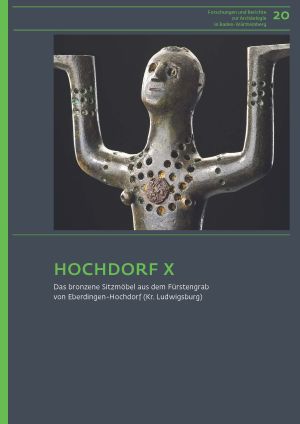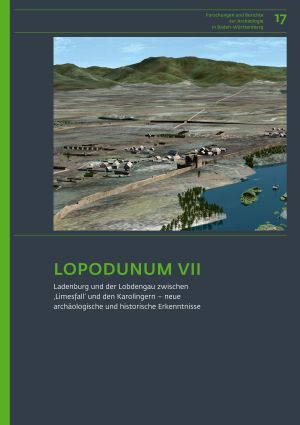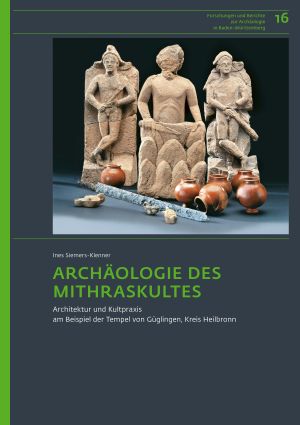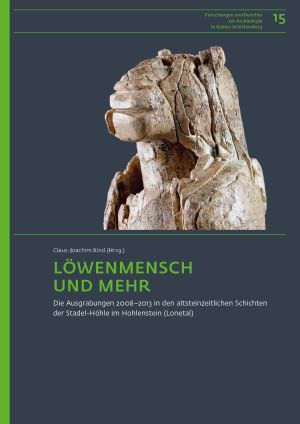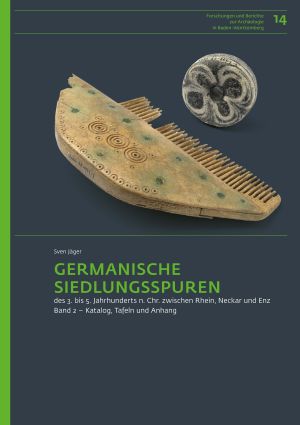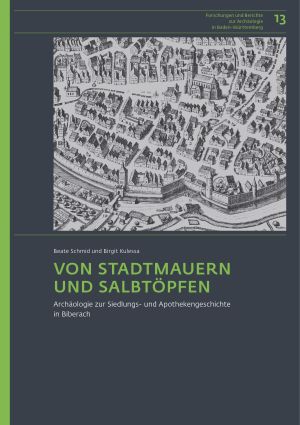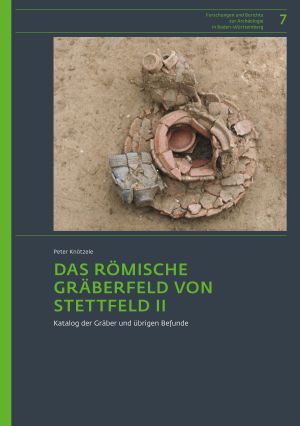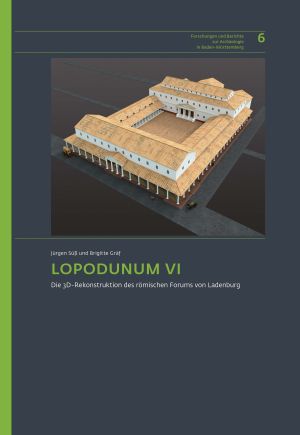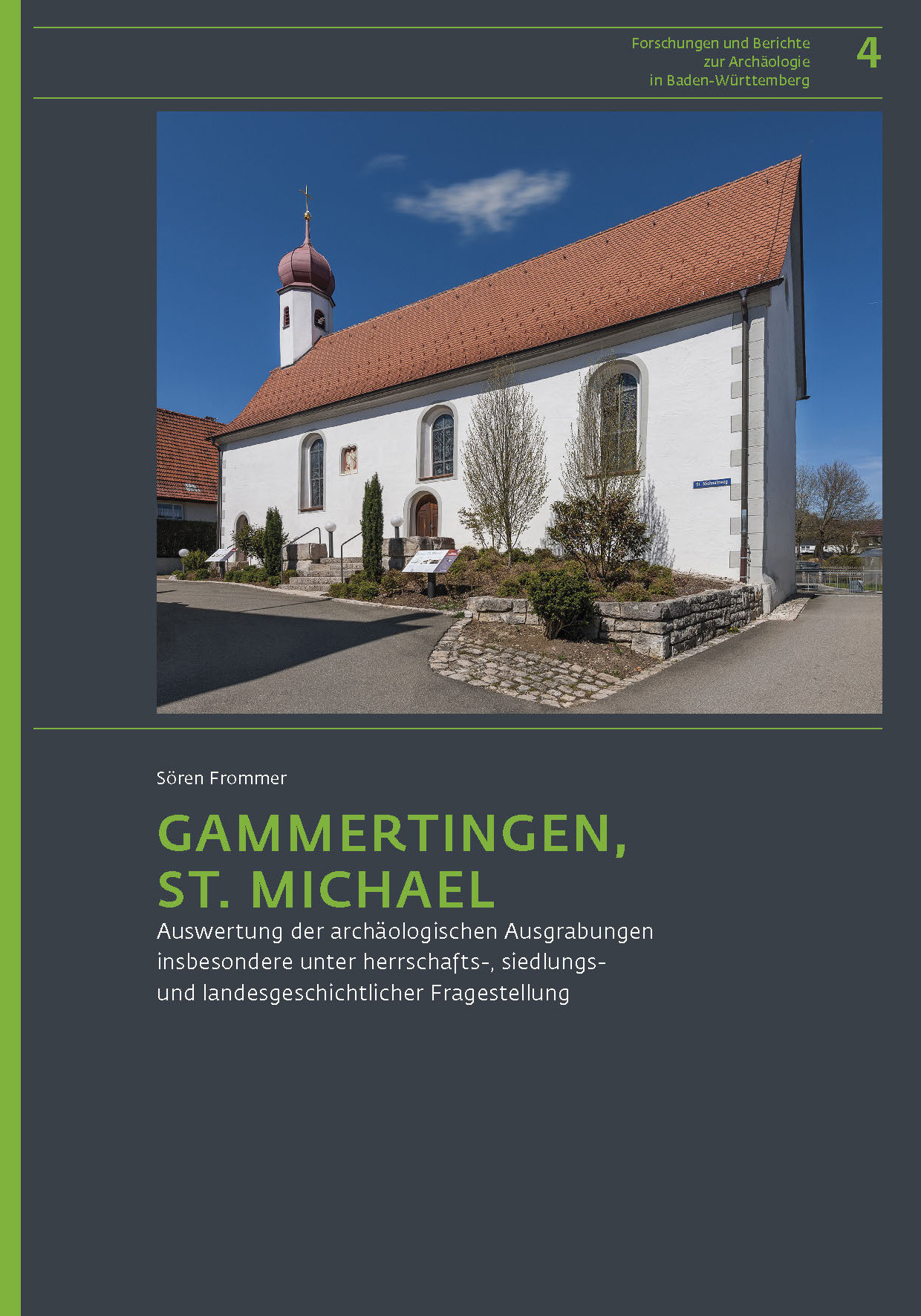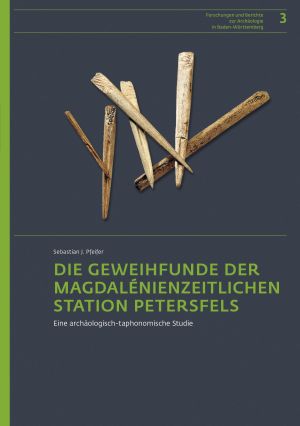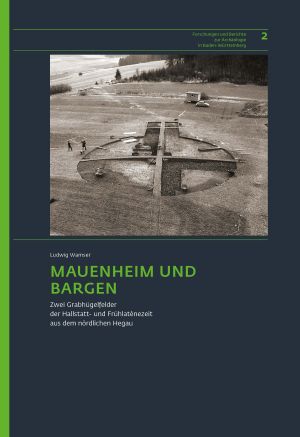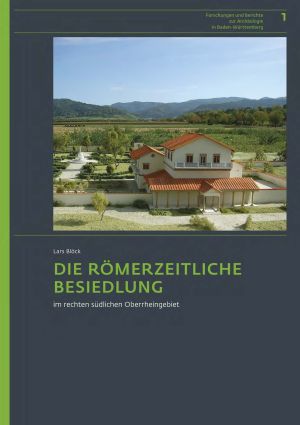Forschungen und Berichte zur Archäologie in Baden-Württemberg
The book series „Forschungen und Berichte zur Archäologie in Baden-Württemberg“ contains monographs and collected volumes on the full time span of prehistory, protohistory, the archaeology of the roman provinces and of the middle ages to early modern times. The books feature excavation results which have been achieved by federal state archaeology in Baden-Wuerttemberg and compiled in university theses or analysed by research projects.
The series is edited by the State Office for Cultural Heritage Preservation of the Regional Administrative Authority of Stuttgart. In 2016, it replaced and pooled the former three parallel series “Forschungen und Berichte zur Vor- und Frühgeschichte in Baden-Württemberg“, „Forschungen und Berichte der Archäologie des Mittelalters in Baden-Württemberg“ and „Materialhefte zur Archäologie in Baden-Württemberg“. The volumes will be published in open access two years after the release of the print edition.
Editors
Landesamt für Denkmalpflege im Regierungspräsidium Stuttgart
Berliner Straße 12
73728 Esslingen am Neckar
E-Mail: abteilung8(at)rps.bwl.de Internet: Landesamt für Denkmalpflege
Published so far
Hochdorf X: Das bronzene Sitzmöbel aus dem Fürstengrab von Eberdingen-Hochdorf (Kr. Ludwigsburg)
More than four decades after its excavation, the presentation of the sitting bench, used in its last function as a funeral rest, completes the basic publications on the inventory of the Late Hallstatt period (c. 530 BC) chamber tomb of Hochdorf. The centrepiece of the volume is a catalogue of the overall appearance of this unique piece of furniture, which is based on digital imaging techniques. This is complemented by descriptions of the findings, the recovery, the restoration and production techniques, which close with the presentation of a replica of the piece. Detailed textile archaeological analyses of the rich adhesions on the funerary couch complement the picture. A further focus is on archaeometallurgical examinations of the furniture’s components and its iron substructure. Questions related to the origin of the object are discussed in a cultural-historical study on its southern and italic connections and on the interpretation of the pictorial programme. The volume is completed by bioarchaeological analyses of the deceased from the central grave as well as other burials from the mound area.
Das Erdwerk der Michelsberger Kultur von Bruchsal „Aue“: Eine lange Geschichte
In the "Aue" area on the north-eastern edge of the small town of Bruchsal in Baden, a double ditch from the Michelsberg culture (around 4300–3600 BC) was discovered in 1986 by aerial survey. In 1987–1993, the ditches, which were preserved over a length of around 550 m, were archaeologically investigated almost in their entirety. A surprising discovery were six burial pits at the edge and under the base of the outer ditch with the skeletons of nine children and seven adults, some in a regular and some in an irregular position.
The carefully documented excavation allowed a detailed reconstruction of the building history of the ditch complex. The analysis of the features revealed that the earthwork never existed in its appearance as it is today, but that it is the result of various anthropogenic and natural transformations over a period of six centuries. However, the discussion about the function of the Michelsberg earthworks cannot be settled in Bruchsal “Aue” either – there are indications of a profane settlement use with a defensive character as well as of cultic or ritual activities.
Konstanz, Obere Augustinergasse: Ein Hinterhofquartier und sein historisch-bauhistorisches Umfeld
The historic centre of Constance, with its historic buildings and excellently preserved archaeological remains, has been one of the focal points of archaeological heritage preservation in the state of Baden-Württemberg since the 1980s. Large-scale excavations were carried out in 1986–1987 in the backyard area of the most important north-south axis in the city, the Hussenstraße. Originally settled in the second half of the 11th century, a higher social class neighbourhood had developed here by the 14th century. The archeological investigations were evaluated in an interdisciplinary approach, starting with the urbanistic and historical context of the residential area and the evaluation of the findings, continuing with the presentation of the finds made of leather, glass, ceramics and metal, and ending with the scientific analysis of the animal bones and insect remains, which allow conclusions about the diet of the inhabitants and the hygienic conditions.
LOPODVNVM VII: Ladenburg und der Lobdengau zwischen ‚Limesfall‘ und den Karolingern
The town of Ladenburg looks back on a rich historical heritage: In the Roman era, Lopodunum was the capital of an extensive municipality, the civitas Ulpia Sueborum Nicrensium, and from the Carolingian period onward, Lobedtenburc is documented as the center of the Lobdengau. For the period in between, written sources are largely missing; all the more important are archaeological features and finds. The most important of these are presented in the volume at hand and embedded in the historical context. For instance, a group of Postumus coins from Ladenburg are presented, new interpretations of the late Roman burgus and the medieval ‘bishop's court’ are discussed, and recent findings on a Carolingian cemetery in the city area are presented. The surroundings of Ladenburg are represented by overviews on the richly equipped early medieval cemeteries of the region and on recent settlement excavations. Critical re-evaluations of written sources as well as historical-archaeological syntheses on the various possible scenarios of the 'Fall of the Limes' and on comparative regions such as the Palatinate in Late Antiquity complete the volume.
Archäologie des Mithraskultes: Architektur und Kultpraxis am Beispiel der Tempel von Güglingen, Kreis Heilbronn
Extensive excavations in Güglingen in the Zabergäu region led to the discovery of two Mithras temples in 1999 and 2002. The first one was built of stone and had been almost entirely deprived of its furnishings. The second, smaller Mithraeum, on the other hand, preserved large parts of the inventory under its collapsed tiled roof. In this timber-framed building, stone monuments, temple dishes, personal belongings of the worshipers, various votive offerings and liturgical equipment were preserved in a hitherto unique state.
The unique archaeological record not only enabled the reconstruction of the building history of both temples, but also for the first time allowed a deep insight into the previously unknown liturgical practice of the Mithras cult. For example, the finds and features suggest that scenes from the mithraic legend were re-enacted in the temples with the use of special lighting effects. The finds from Mithraeum II confirm the practical execution of initiations in the form of trials of courage or symbolic death experiences, which had been assumed for a long time from written sources. The timber-framed building from Güglingen is also the oldest evidence of the distinctive temple type “Mithraeum” from the time around 115/125 AD and thus lends new momentum to the question of the spread of this cult.
Löwenmensch und mehr: Die Ausgrabungen 2008–2013 in den altsteinzeitlichen Schichten der Stadel-Höhle im Hohlenstein (Lonetal), Gemeinde Asselfingen, Alb-Donau-Kreis
The Hohlenstein in the Lone Valley (Gem. Asselfingen, Alb-Donau-Kreis) is one of the most important Palaeolithic sites in southern Germany. It became famous in particular for the “Lion Man”, found in 1935 – a unique mammoth ivory carving depicting a hybrid creature from the early Upper Palaeolithic period about 35,000 to 40,000 years ago. The Hohlenstein belongs to a group of caves in the Swabian Alb that have yielded the oldest known evidence of figurative art in the entire history of mankind, and for this reason became UNESCO World Heritage Sites in 2017.
Since the current state of preservation of the layers in the cave was largely unknown, new excavations were carried out between 2008 and 2013 by the State Office for Cultural Heritage Preservation in the Regional Council of Stuttgart. It turned out that both inside the cave and on its forecourt there were still intact layers containing finds. Surprisingly, also new fragments of the Lion Man figure came to light.
Germanische Siedlungsspuren des 3. bis 5. Jahrhunderts n. Chr. zwischen Rhein, Neckar und Enz
The period from the 3rd to the 5th century AD brought a radical change to the area of present-day Baden-Württemberg: the limes of the Roman province of Germania Superior was abandoned as a result of political turmoil and military conflicts, and many inhabitants left the region. Subsequently, a more basic Germanic settlement system was established where Roman villages and rural estates had previously existed. Recent excavations provide information about the development of individual sites during this period and the changes in the settlement landscape. Why did some places have a Germanic successor settlement and others not? Were romanised germanic people who already lived in the Roman provinces a nucleus of the occupation of the 3rd to 5th centuries? These and other questions are addressed in the study at hand on the basis of 32 sites from a study area extending form the Rhine plain over the Kraichgau to the middle Neckar region and from the southern foothills of the Odenwald to the Enz valley.
Germanische Siedlungsspuren des 3. bis 5. Jahrhunderts n. Chr. zwischen Rhein, Neckar und Enz
The period from the 3rd to the 5th century AD brought a radical change to the area of present-day Baden-Württemberg: the limes of the Roman province of Germania Superior was abandoned as a result of political turmoil and military conflicts, and many inhabitants left the region. Subsequently, a more basic Germanic settlement system was established where Roman villages and rural estates had previously existed. Recent excavations provide information about the
Von Stadtmauern und Salbtöpfen: Archäologie zur Siedlungs- und Apothekengeschichte in Biberach
For centuries, the town of Biberach preserved its largely undisturbed town centre with a considerable number of late medieval buildings. This volume presents the results of two excavations at very different locations within the medieval urban structure. The analysis of the excavation on Viehmarktplatz focuses on questions of the beginning of the settlement and the development on its periphery, and thus on the first town fortifications. The investigation of the building at Marktplatz 7, on the other hand, is concerned with the building history and use of a late medieval town house in a central location between the church and the market. In the course of its long history it was used by a pharmacist, among others. By presenting and interpreting the features and the finds from both excavations, the authors create a multifaceted picture of everyday life in a medieval town.
Das römische Gräberfeld von Stettfeld II: Katalog der Gräber und übrigen Befunde
From 1979 to 1981, one of the largest Roman cemeteries was excavated in Stettfeld (municipality of Ubstadt-Weiher, district Karlsruhe). Knowledge of Roman Stettfeld, however, has so far been limited mainly to the associated vicus. Immediately after the excavation, interdisciplinary analyses with a modern approach were started. The first volume on the Roman cemetery was published as early as 1988, dealing with the anthropological and osteological investigations and giving a first impression of the importance of the Roman necropolis. In the second volume, the almost 390 graves and other features are presented from an archaeological point of view. For the first time, the complete grave ensembles and features are published and thus made accessible for further research.
LOPODVNVM VI: Die 3D-Rekonstruktion des römischen Forums von Ladenburg Beschreibung und Begründung der Nachbildung
The centre of the Roman town of Lopodunum was dominated by a complex of buildings consisting of a forum and a basilica, which was characterised by its enormous area and volume. However, apart from remnants of the foundations, only very few remains of the buildings have been preserved in the medieval core of today's Ladenburg. This treatise explains the considerations that have led to the virtual 3D reconstruction of the ancient forum as it is presented today in the Lobdengau Museum in Ladenburg. In addition to a discussion of the reconstruction approaches, perspectives for further scientific analyses of the historically important Roman building complex are presented.
Die Konstanzer Marktstätte im Mittelalter und in der Neuzeit
Constance is one of the towns in Baden-Württemberg that survived World War II largely undamaged. Due to extensive archaeological remains, which are particularly well preserved under the embankments of the former lake shore, the historic centre of Constance became one of the focal points of the federal state's archaeological heritage management since the 1980s. From 1989 to 1992, large-scale excavations were carried out in the area of the “Marktstätte” (marketplace), which stood out by an exceptional density of archaeological features and large quantities of find material. The detailed analysis of the features and finds presented in this volume provides new insights into the urban development during the Middle Ages and early modern times. In addition to building development, the focus is on medieval land reclamation, harbour construction and early modern marketplace use.
Additional infomations you find here.
Gammertingen, St. Michael: Auswertung der archäologischen Ausgrabungen insbesondere unter herrschafts-, siedlungs- und landesgeschichtlicher Fragestellung
Located on the edge of the late medieval town of Gammertingen, the unimposing chapel of St. Michael is a relic of a high nobility estate of the 10th–12th centuries AD, whose roots go back to the Merovingian period. Interdisciplinary analyses of the archaeological excavations give an extraordinary insight into the emergence and development of a medieval dynastic estate and at the same time indicate the role of local tradition already in the early days of aristocratic development. Starting immediately with the first massive church built around 980 AD, the chapel is used as a dynastic burial site by the resident high nobility. But also for later phases, St. Michael’s chapel provides first-hand information, for example on the epochal conflict between Gammertingen’s town lord Dietrich von Speth and Duke Ulrich of Württemberg in the 16th century.
Additional infomations you find here.
Die Geweihfunde der magdalénienzeitlichen Station Petersfels: Eine archäologisch-taphonomische Studie
The Magdalenian site Petersfels (Lkr. Konstanz) with its extensive lithic and organic inventory is one of the most important Palaeolithic sites in Central Europe. The study at hand deals with the Late Upper Palaeolithic antler industry from the Petersfels, with special focus on archeology and taphonomy. In the course of investigations on recent reindeer antlers in western Greenland inland, Sebastian J. Pfeifer describes and classifies a variety of natural changes. On the basis of these observations, it is possible to identify and distinguish the effects of taphonomic processes and anthropogenic modifications on the palaeolithic find material. The analysis shows that both shed antlers and specimens still adhering to the skull were brought into and stored as well as processed at the Petersfels site. Highly rationalised production is in contrast with extensive consumption of raw material and the fact that damaged tools have almost never been repaired.
Mauenheim und Bargen: Zwei Grabhügelfelder der Hallstatt- und Frühlatènezeit aus dem nördlichen Hegau
The monograph deals with the Hallstatt cemetery of Immendingen-Mauenheim (district of Tuttlingen), which comprises 23 burial mounds and at least 10 small cremation graves between the mounds, and with the necropolis of Engen-Bargen (district of Constance), which consists of five tumuli. Both sites are located about 700 m apart in the northern Hegau, a few kilometres south of the Danube, between the Alps and the Black Forest. The study is based on a dissertation from the 1970s and is supplemented by new research devoted to specific finds and social and economic aspects. Animal grave goods from the tombs were analysed achaeozoologically. Anthropological studies of the skeletons from the Hallstatt period as well as research on mobility and nutritional status of humans and animals contribute to the reconstruction of Iron Age living conditions in south-western Germany.
Die römerzeitliche Besiedlung im rechten südlichen Oberrheingebiet
Written as a doctoral thesis at the University of Freiburg, the volume investigates the Roman settlement in the southernmost section of the right side of the Upper Rhine region between Kaiserstuhl, Black Forest and the river Alb, a tributary of the High Rhine. The extensive study is based on a catalogue collection and evaluation of the more than 750 Roman sites that are known from the region. Following a critical assessment of sources, the analysis first deals with the settlement types and streets which subdued and developed the landscape. The focus is on questions of derivation, development and the economic basis of settlements. The study is completed by a reconstruction of the settlement processes on the right side of the Upper Rhine valley starting with the expansion of Rome into the region shortly after the begin of the common era until the end of the Roman Empire in the 5th century AD.



